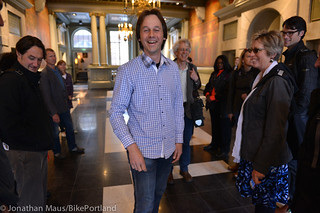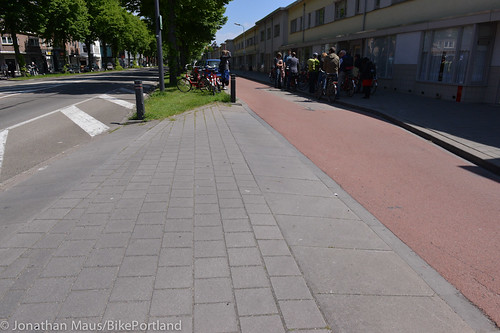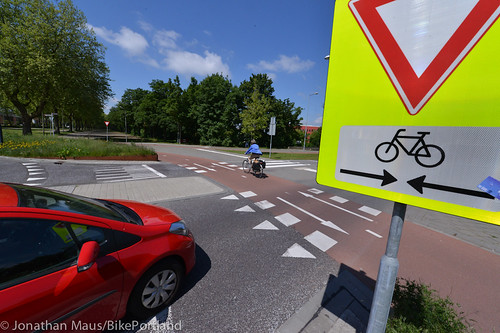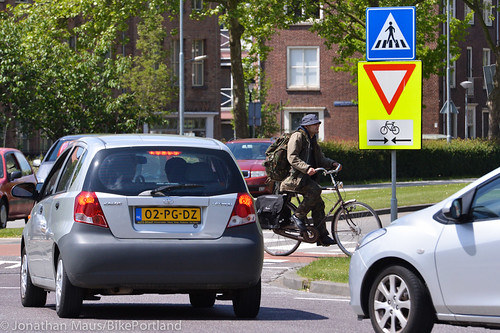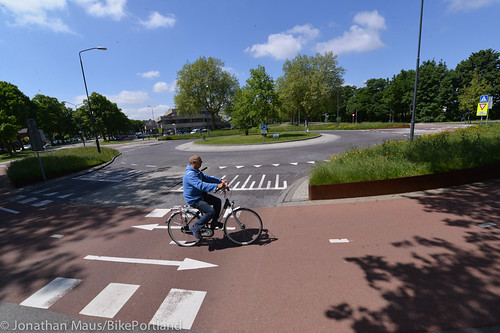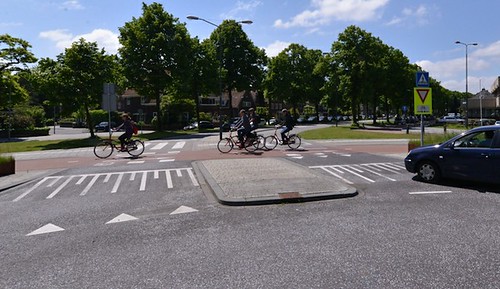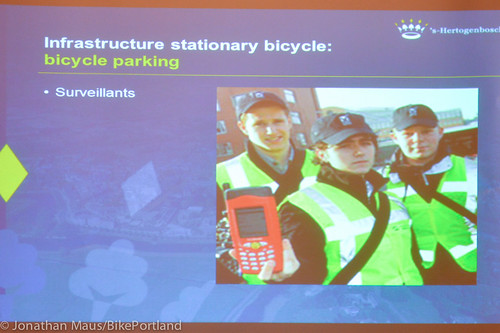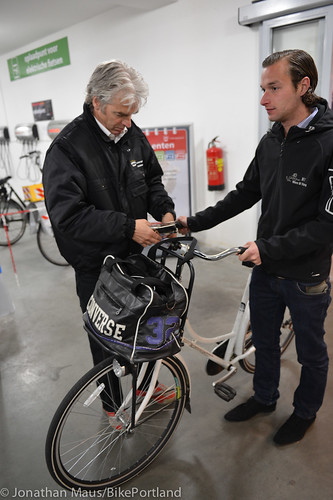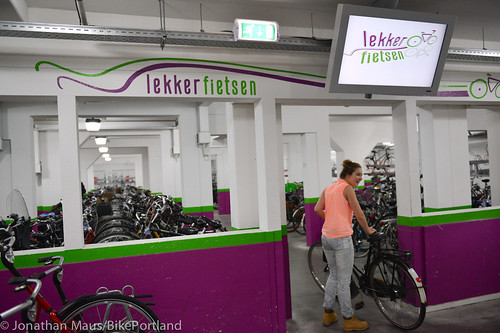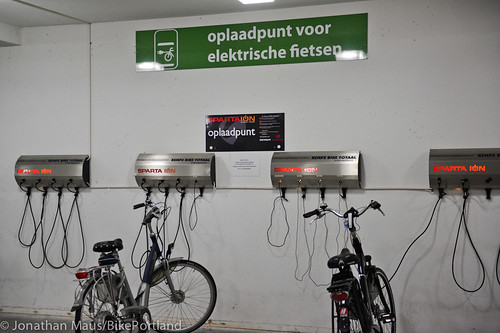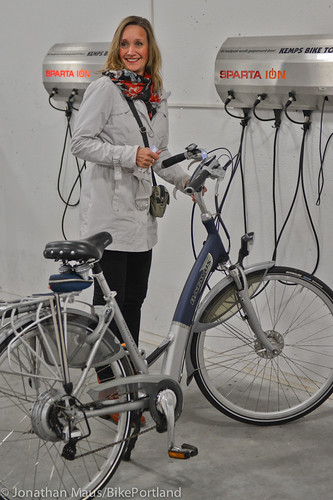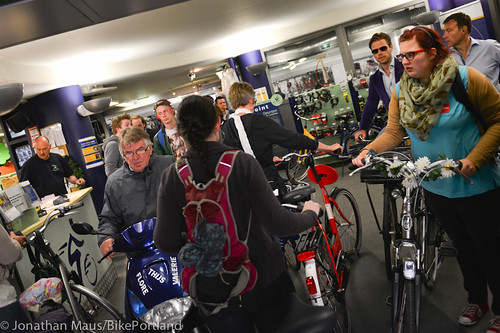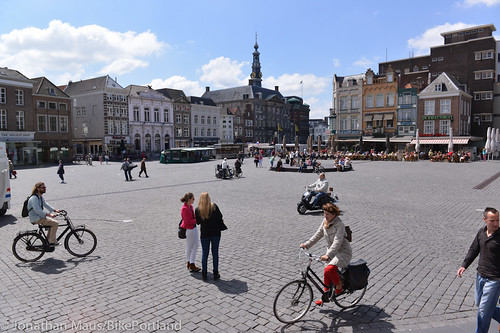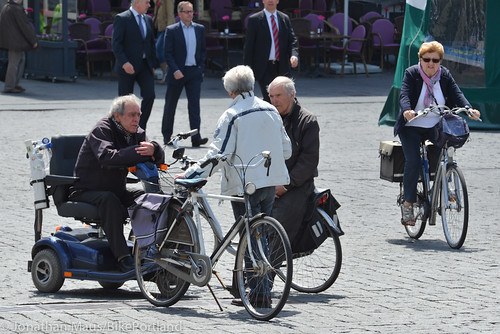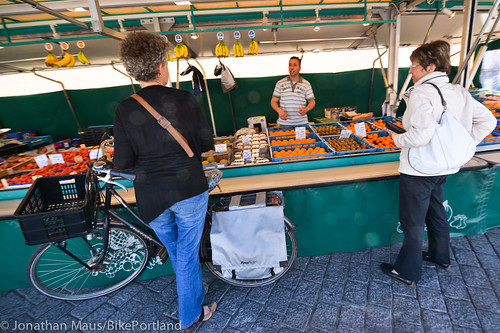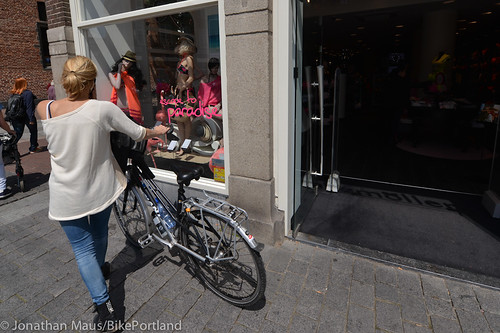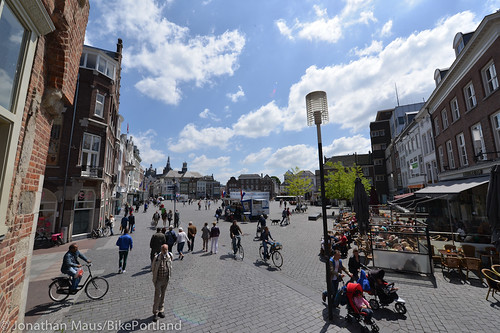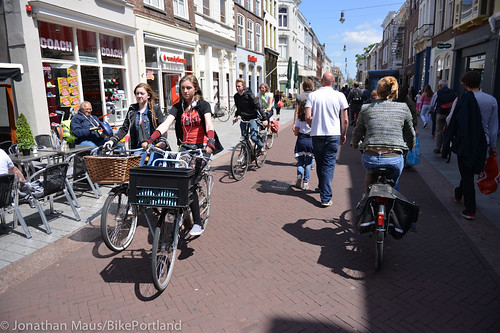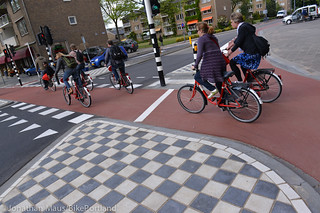
Den Bosch, and it’s paying off in more ways than one.
(Photo © J. Maus/BikePortland)
This is part of ongoing coverage of the Green Lane Project/Bikes Belong Netherlands Study Tour.
‘Lekker Fietsen’ is a promotional slogan used by ‘s-Hertogenbosch, a town about 60 miles south of Amsterdam. It means “Nice Cycling” and today we found out there’s plenty of that in this charming town of 142,000 people. Den Bosch, as its known locally, is one of the Netherlands’ up-and-coming cycling cities. In fact, it currently holds the title of Cycling City of the Year as awarded by the Dutch Cyclists’ Union.
From a stunning roundabout with two-way bicycle traffic (seriously!) to a nifty bike theft prevention campaign, Den Bosch is full of inspiring bicycle innovations. After falling behind other Dutch cities, they launched a focused effort in to increase cycling in 2009 and it seems to be paying off. Streets in their city center are teeming with bikes and economic vitality (while cars are nowhere in sight) and their bicycle mode is growing. Between 2009 and 2011, their percentage of daily trips made by bicycle went up 4 points, from 33 to 37 percent. They’re the only city in the Netherlands that has seen such an increase in recent years.
Today we got a rundown of their latest programs and projects from one of the city’s traffic engineers, Arnold Bongers. Bongers shared some of their work on cycling and then led us on a bike tour through town.
Like all other Dutch towns, Den Bosch’s approach to cycle planning follows five core principles: coherence, directness, attractiveness, safety and comfort. But unlike other places we’ve visited and heard about Den Bosch is going above and beyond — both in promoting cycling to the public and in grabbing opportunities to do bold projects.
Cycle Streets
“It’s really cutting-edge. They’re using user perception to drive function.”
— Zach Vanderkooy, Bikes Belong
Take their concept of “cycle streets” for instance. They’ve taken a standard side road (adjacent to a neighborhood arterial) and turned it into a de facto cycle track with one major difference — people are allowed to drive on it. Bongers and his colleagues used red asphalt (typically used on cycle tracks) and made it look like a cycle track. The street is narrow and traffic-calmed so people driving on it don’t feel like going fast. Prior to its conversion to a cycle street, Bongers said riders would sometimes scoot over and make room for drivers who wanted to pass. Now the idea is that people on bikes take the lane. “The cyclist has to feel strong and stay on their bicycle in the middle of the street,” he said.
Zach Vanderkooy with Bikes Belong, who’s on his ninth study tour in the Netherlands, said this is “pure psychology.” “It’s really cutting-edge. They’re using user perception to drive function. If you’re driving on this you feel uncomfortable.”
Another cool thing about the cycle streets is that since the city didn’t have to remove any auto parking the adjacent residents didn’t resist the project at all.
A roundabout with two-way bicycle traffic
A few blocks away we then came to perhaps the most jaw-dropping engineering feat I’ll see the entire trip: a roundabout with two-way bicycle traffic. Think about that for a minute. Roundabouts are already somewhat notorious for the tricky crossings they create for people on bikes. Now add a stream of people coming in the opposite direction. This design was motivated by a desire to avoid delays at all costs — especially for people riding bicycles.
This two-way bicycle roundabout employs some of the standard Dutch intersection treatments. People cross each other’s paths at right angles and the folks in cars are looking directly at the bicycle path as they approach it (and are thus much less likely to say, “I never saw him!”). They make liberal use of paint, shark’s teeth (for yielding), signage, and so on.
The intersection gets moderate levels of traffic and while we observed it everything seemed to work well. However, Bongers acknowledged that their two-way roundabouts (they have several) have a higher collision rate. “There’s a high level of accidents,” he said, “more than I would like; but not more than before when this intersection had traffic signals.”
See what it’s like to ride around the intersection in the video below:

Park and Ride
The next innovative project we learned about was a park and ride station (“transferia”) situated two kilometers outside the Den Bosch city center. Bongers said the City wanted to limit the number of private cars in their compact and charming downtown district, so they built an auto parking lot a bit further out. For just $2 Euros a day, people can park their cars an then hop on a bus (for free) for a quick ride into downtown. They can also grab a free rental bike if they’d prefer to cycle the two kilometers into town (and yes there a separated path the entire way).
While reducing the number of cars in the city center (which they want to preserve for people instead), the Park and Ride has also had an unintended impact. It turns out that older folks who live in the suburbs don’t like to drive on downtown streets. Word has spread among senior citizens and now people are shopping and visiting downtown Den Bosch specifically because this park and ride exists. Put another way, this park and ride makes Den Bosch a more attractive city to shoppers who don’t want the hassle and expense of driving and parking in the cramped downtown environment.
Security “surveillants”
To help take a bite out of stolen bike crime, Bongers and his colleagues have equipped a group of workers they call “surveillants” to monitor theft hot spots. The workers are recruited from work programs run by social service organizations. They monitor bike parking areas in bright reflective vests. They have no authority to issue tickets, but the visibility alone is a huge theft deterrent. They also use handheld scanners to look up registration numbers and then check them against a national database. If a bike comes up as stolen, they call in the police to do the dirty work. Bongers said they work with 10 surveillants and the cost of the program is only $10,000 per year (the workers are paid by the social service orgs). Since the program started bike theft is down by 30%.
World class bike parking
Den Bosch offers truly luxurious bike parking services. There are several bike parking garages around town. When you arrive at one of them you are welcomed by a friendly attendant who proceeds to strap a claim tag to your bike. It’s that easy. The service is free so you just walk in and walk out. The garages were clean and well lit and buzzing with activity. We watched as shoppers came in with bags full of items just purchased in local shops. In addition to bicycles, you can also grab a stroller (free) or fill up your electric bike via their charging stations.
Market Square
At the center of Den Bosch is Market Square, a grand plaza teeming with life. But it wasn’t always like that. In the 1970s cars dominated the square. While they got cars out of the square in the 1990s, people weren’t allowed to ride bicycles through it. That all changed in 2009 when the city decided to reverse the policy. Bongers said the change wasn’t easy. They had to convince the business owners and the police that it wouldn’t be a problem.
Bongers said bicycle access through the square was an important link in the system. He also wanted the 12,000 people who live on the square to be able to ride their bikes all the way to their front doors. “We were convinced they could share the space.”
It turns out Bongers was right. As you can see in the photos below, even with crowds and mixing of biking and walking, Market Square is a huge success…
You’re also allowed to ride on the side streets that lead to the square…
Overall, I was really impressed by Den Bosch. The bike infrastructure was so pristine, spot-on, and consistent, I felt like I was riding around inside a Dutch bicycle planning textbook. At the end of his presentation today, Bongers summed up the approach that has served him and his colleagues so well: “Have courage, grab opportunities, don’t fight the car, quality counts, have high ambitions, and think positively.”
— See a lot more photos of the excellent cycling in ‘s-Hertogenbosch in the gallery.


